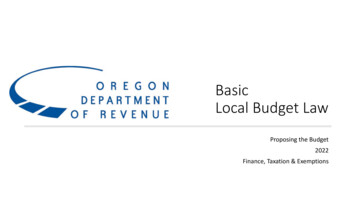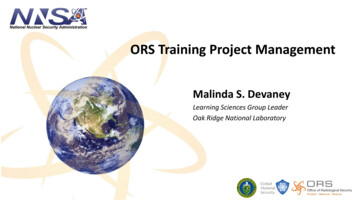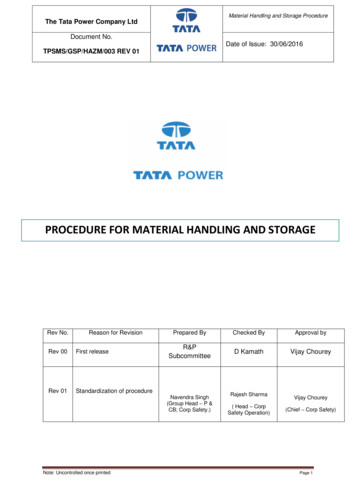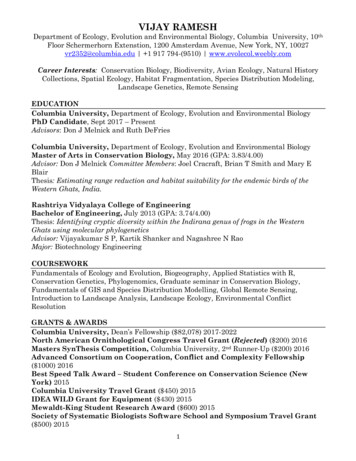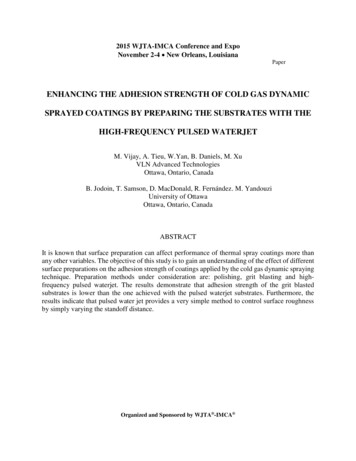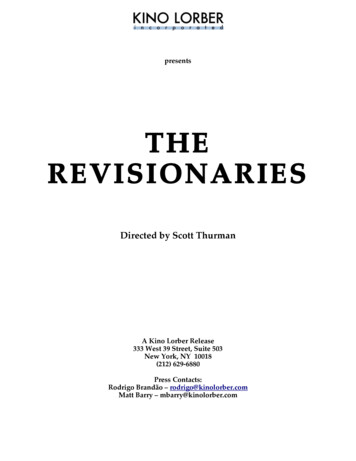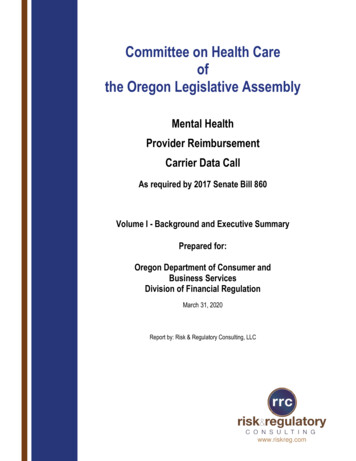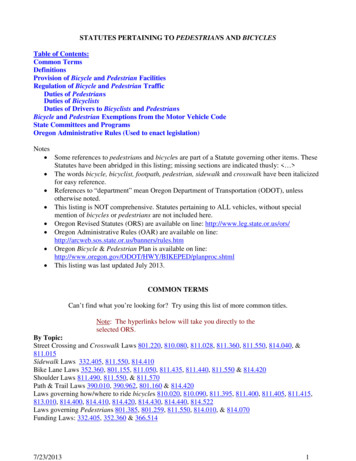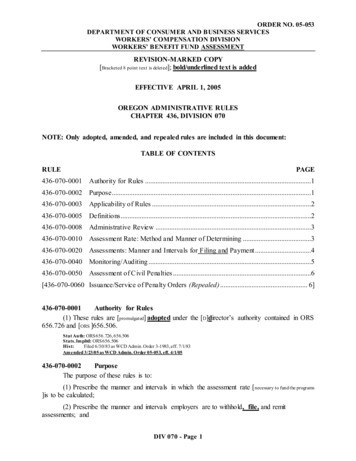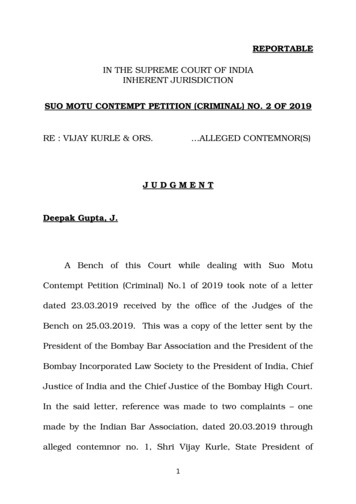
Transcription
REPORTABLEIN THE SUPREME COURT OF INDIAINHERENT JURISDICTIONSUO MOTU CONTEMPT PETITION (CRIMINAL) NO. 2 OF 2019RE : VIJAY KURLE & ORS. ALLEGED CONTEMNOR(S)JUDGMENTDeepak Gupta, J.A Bench of this Court while dealing with Suo MotuContempt Petition (Criminal) No.1 of 2019 took note of a letterdated 23.03.2019 received by the office of the Judges of theBench on 25.03.2019. This was a copy of the letter sent by thePresident of the Bombay Bar Association and the President of theBombay Incorporated Law Society to the President of India, ChiefJustice of India and the Chief Justice of the Bombay High Court.In the said letter, reference was made to two complaints – onemade by the Indian Bar Association, dated 20.03.2019 throughalleged contemnor no. 1, Shri Vijay Kurle, State President of1
Maharashtra and Goa of the Indian Bar Association, and thesecond complaint dated 19.03.2019 made by alleged contemnorno. 2, Shri Rashid Khan Pathan, National Secretary of theHuman Rights Security Council.It was mentioned that thesecomplaints have not only been sent to the President of India andthe Chief Justice of India but also have been circulated in thesocial media and the complaints were attached as Annexures 1and 2 to the said letter. The Bench took note of the letter and thecomplaints attached to the said letter and specifically noted theprayers made in both the complaints and found that both thecomplaints are substantially similar. The Bench on noting theallegations made in the complaints was of the view thatscandalous allegations have been made against the members ofthe said Bench and, therefore, notice was issued to Shri VijayKurle, alleged contemnor no. 1, Shri Rashid Khan Pathan, allegedcontemnor no. 2, Shri Nilesh Ojha, alleged contemnor no. 3 andShri Mathews Nedumpara, alleged contemnor no. 4. The Benchalso directed that the matter be placed before the Chief Justice ofIndia to constitute an appropriate Bench to hear and decide thecontempt case.2
tion, being Criminal M.P. No. 60568/2019 for discharge inwhich he stated that he barely knew Shri Vijay Kurle and ShriNilesh Ojha, and did not know Shri Rashid Khan Pathan at all.He denied any role in sending those complaints. Therefore, videorder dated 02.09.2019 we had discharged Shri MathewsNedumpara but made it clear that if during the course ofproceedings any evidence comes up against him, he would besummoned again.On the same date, Shri Nilesh Ojha whoappears in person stated that the Registry has not given completecopy of the annexures attached with the letter of the Bombay BarAssociation and Bombay Incorporated Law Society to him alongwith the notice.annexures to him.The Registry was directed to supply theOn 30.09.2019 we were informed that theRegistry has not given complete annexures. Thereafter, we haddirected the Registry to supply 3 sets of Annexures P1 to P15attached with the letter which were sent to alleged contemnornos. 1 to 3.On the same date, we appointed Shri SidharthLuthra, learned senior counsel, as amicus curiae to assist theCourt. On 04.11.2019, alleged contemnor nos. 1 to 3 admitted3
that all the documents have been supplied to them andthereafter, fresh replies were permitted to be filed.3.In the letter of the Bombay Bar Association and theBombay Incorporated Law Society reference was made not only tothe allegations in the complaints levelled against the 2 Hon’bleJudges of this Court but also other allegations were made whichindicated that alleged contemnor nos. 1 to 3had committedcontempt of the Bombay High Court also. On 09.12.2019 we hadclarified that in view of the original order taking suo motu noticeand the documents placed on record, the charge against ShriVijay Kurle, alleged contemnor no. 1 was only in respect of thescandalous allegations levelled against 2 Judges of this Court inthe letter dated 20.03.2019 sent by him as State President ofMaharashtra and Goa of the Indian Bar Association.We havealso clarified that as far as Shri Rashid Khan Pathan, allegedcontemnor no. 2, is concerned, the charge against him onlyrelates to the scandalous allegations made against 2 Judges ofthis Court in the letter dated 19.03.2019 sent by him. As far asShri Nilesh Ojha, alleged contemnor no. 3 was concerned, theonly document against him was also the letter dated 20.03.20194
which letter was not signed by him, but admittedly, he isPresident of the Indian Bar Association.We had givenopportunity to Shri Nilesh Ojha to explain his position whetherthe letter dated 20.03.2019 was sent with his consent or underhis authority.4.It would be pertinent to mention that Shri Vijay Kurle andShri Rashid Khan Pathan have not denied that they are theauthors of the letters which are signed by them.5.The basis of the present contempt are the two letters gedcontemnor nos. 1 and 2 i.e. Shri Vijay Kurle and Shri RashidKhan Pathan respectively. These letters are very lengthy runninginto more than 250 pages combined. Therefore, it would not befeasible to extract the entire letters but we have no doubt in ourmind that the tenor of the letters is highly disrespectful, andscandalous and scurrilous allegations have been levelled against2 Judges of this Court.6.The three alleged contemnors have raised a number ofpreliminary issues. We may summarise the same as follows: 5
(i)That the Bench of Justice R. F. Nariman and JusticeVineet Saran could not have taken cognizance of the casebecause the case was not assigned to them by the ChiefJustice and that both the Judges acted as Judge in theirown cause.That the Bench has not suo motu taken notice of the(ii)contempt and therefore the Registry cannot treat it as a(iii)suo motu petition.That even in suo motu contempt proceedings the consent(iv)of the Attorney General is necessary.That the proper procedure of framing a charge is notfollowed because the defects at the initial stage cannot be(v)cured by later orders/developments.That the Judges were bound to disclose the source ofinformation.Powers of the Supreme Court7.Before we deal with the objections individually, we need tounderstand what are the powers of the Supreme Court of India inrelation to dealing with contempt of the Supreme Court in thelight of Articles 129 and 142 of the Constitution of India whenread in conjunction with the Contempt of Courts Act, 1971.According to the alleged contemnors, the Contempt of Courts Act6
is the final word in the matter and if the procedure prescribedunder the Contempt of Courts Act has not been followed then theproceedings have to be dropped.On the other hand, ShriSidharth Luthra, learned amicus curiae while making referenceto a large number of decisions contends that the Supreme Courtbeing a Court of Record is not bound by the provisions of theContempt of Courts Act.The only requirement is that theprocedure followed is just and fair and in accordance with theprinciples of natural justice.Article 129 of the Constitution of India reads as follows:“129. Supreme Court to be a court of record. TheSupreme Court shall be a court of record and shall haveall the powers of such a court including the power topunish for contempt of itself.”A bare reading of Article 129 clearly shows that this Court beinga Court of Record shall have all the powers of such a Court ofRecord including the power to punish for contempt of itself. Thisis a constitutional power which cannot be taken away or in anymanner abridged by statute.Article 142 of the Constitution of India reads as follows:7
“142. Enforcement of decrees and orders of SupremeCourt and orders as to discovery, etc. (1) TheSupreme Court in the exercise of its jurisdiction maypass such decree or make such order as is necessary fordoing complete justice in any cause or matter pendingbefore it, and any decree so passed or order so madeshall be enforceable throughout the territory of India insuch manner as may be prescribed by or under any lawmade by Parliament and, until provision in that behalfis so made, in such manner as the President may byorder prescribe.(2) Subject to the provisions of any law made in thisbehalf by Parliament, the Supreme Court shall, asrespects the whole of the territory of India, have all andevery power to make any order for the purpose ofsecuring the attendance of any person, the discovery orproduction of any documents, or the investigation orpunishment of any contempt of itself.”Article 142 also provides that this Court can punish any personfor contempt of itself but this power is subject to the provisions ofany law made by parliament. A comparison of the provisions ofArticle 129 and clause (2) of Article 142 clearly shows thatwhereas the founding fathers felt that the powers under clause92) of Article 142 could be subject to any law made byparliament, there is no such restriction as far as Article 129 isconcerned. The power under clause (2) of Article 142 is not theprimary source of power of Court of Record which is Article 129and there is no such restriction in Article 129. Samaraditya Pal8
in the Law of Contempt 1 has very succinctly stated the legalposition as follows:“Although the law of contempt is largely governed by the1971 Act, it is now settled law in India that the HighCourts and the Supreme Court derive their jurisdictionand power from Articles 215 and 129 of theConstitution. This situation results in giving scope for“judicial self dealing”.The High Courts also enjoy similar powers like the SupremeCourt under Article 215 of the Constitution. The main argumentof the alleged contemnors is that notice should have been issuedin terms of the provisions of the Contempt of Courts Act and anyviolation of the Contempt of Courts Act would vitiate the entireproceedings. We do not accept this argument. In view of the factthat the power to punish for contempt of itself is a constitutionalpower vested in this Court, such power cannot be abridged ortaken away even by legislative enactment.8.To appreciate the rival contention, we shall have to makereference to a number of decisions relied upon by both theparties.The first judgment on the point is Sukhdev SinghSodhi v. The Chief Justice and Judges of the Pepsu HighPgs. 9 10, The Law of Contempt: Contempt of Courts and Legislatures, Fifth Edn.,LexisNexis Butterworths Wadhwa, Nagpur (2013)19
Court2. It would be pertinent to mention that the said judgmentwas given in the context of the Contempt of Courts Act, 1952.The issue before this Court in the said case was whethercontempt proceedings could said to be the proceedings under theCriminal Procedure Code, 1973 (Cr.PC) and the Supreme Courthad the power to transfer the proceedings from one court toanother under the Cr.PC. Rejecting the prayer for transfer, thisCourt held as follows: “ .We hold therefore that the Code of CriminalProcedure does not apply in matters of contempt triableby the High Court. The High Court can deal with itsummarily and adopt its own procedure. All that isnecessary is that the procedure is fair and that thecontemner is made aware of the charge against him andgiven a fair and reasonable opportunity to defendhimself. This rule was laid down by the Privy Council inIn re Pollard (L.R. 2 P.C. 106 at 120) and was followed inIndia and in Burma in In re Vallabhdas (I.L.R. 27 Bom.394 at 390) and Ebrahim Mamoojee Parekh v. KingEmperor (I.L.R. 4 Rang. 257 at 259 261). In our viewthat is still the law.”9.A Constitution Bench of this Court in Shri C. K. Daphtaryand Others v. Shri O.P. Gupta and Others 3 was dealing with acase where the contemnor had published a pamphlet castingscurrilous aspersions on 2 Judges of this Court.231954 SCR 4541971 (1) SCC 62610During the
course of argument, the contemnor raised a plea that all theevidence has not been furnished to him and made a request thatthe petitioner be asked to furnish the “pamphlet” or “book”annexed to the petition.The Court rejected this argumentholding that the booklet/pamphlet had been annexed to thepetition in original and the Court had directed that the matter bedecided on affidavits.10.In respect of the absence of a specific charge being framed,the Court held that a specific charge was not required to beframed and the only requirement was that a fair procedureshould be followed. Dealing with the Contempt of Courts Act,1952 this Court held as follows: “58. We are here also not concerned with any law madeby Parliament. Article 129 shows that the Supreme Courthas all the powers of a Court of Record, including thepower to punish for contempt of itself; and Article 142(2)goes further and enables us to investigate any contemptof this tionsSukhdev Singh Sodhi’s case (supra) and held as follows: “78. In our view that is still the law. It is in accordancewith the practice of this Court that a notice was issued tothe respondents and opportunity given to them to fileaffidavits stating facts and their contentions. At onestage, after arguments had begun Respondent No. 1asked for postponement of the case to engage some11in
lawyers who were engaged in fighting elections. Werefused adjournment because we were of the view thatthe request was not reasonable and was made with aview to delay matters. We may mention that the firstrespondent fully argued his case for a number of days.The procedure adopted by us is the usual procedurefollowed in all cases.”12.According to the alleged contemnors, both the aforesaidjudgments are per incuriam after coming into force of theContempt of Courts Act, 1971.They are definitely not perincuriam because they have been decided on the basis of the lawwhich admittedly existed, but for the purposes of this case, weshall treat the argument of the alleged contemnors to be that thejudgments are no longer good law and do not bind this Court. Ithas been contended by the alleged contemnors that both theaforesaid cases are overruled by later judgments. We shall nowrefer to some of the decisions cited by the parties.13.In P.N. Duda v. P.Shiv Shanker and Others4 therespondent, Shri P. Shiv Shiv Shanker, who was a former judgeof the High Court and was the Minister for Law, Justice andCompany Affairs delivered a speech which was said to becontemptuous. A petition was filed by the petitioner P. N. Dudawho was an advocate of this Court but this Court declined to4(1988) 3 SCC 16712
initiate contempt proceedings. At the outset, we may note thatwhile giving the reasons for not initiating contempt, though thisCourt held that the contempt petition was not maintainable, itwent into the merits of the speech delivered by Shri P. ShivShanker and held that there was no imminent danger ofinterference with the administration of the justice and bringingadministration into disrepute.It was held that Shri P. ShivShanker was not guilty of contempt of this Court. Having heldso, the Court went on to decide whether the petition could havebeen entertained on behalf of Shri Duda. In the said petition,Shri Duda had written a letter to the Attorney General seekingconsent for initiating contempt proceedings against Shri P. ShivShanker. A copy of the said letter was also sent to the SolicitorGeneral of India. While seeking consent, the petitioner had alsostated that the Attorney General may be embarrassed to giveconsent for prosecution of the Law Minister and in view of thesaid allegations, the Attorney General felt that the credibility andauthority of the office of the Attorney General was underminedand therefore did not deny or grant sanction for prosecution. TheCourt held that the petitioner could not move the Court forinitiating contempt proceedings against the respondent without13
consent of the Attorney General and the Solicitor General. Therelevant portion of the judgment reads as follows: “39. The question of contempt of court came up forconsideration in the case of C.K. Daphtary v. O.P. Gupta.In that case a petition under Article 129 of theConstitution was filed by Shri C.K. Daphtary and threeother advocates bringing to the notice of this Courtalleged contempt committed by the respondents. Therethis court held that under Article 129 of the Constitutionthis Court had the power to punish for contempt of itselfand under Article 143(2) it could investigate any suchcontempt. This Court reiterated that the Constitutionmade this Court the guardian of fundamental rights. ThisCourt further held that under the existing law ofcontempt of court any publication which was calculatedto interfere with the due course of justice or properadministration of law would amount to contempt ofcourt. A scurrilous attack on a Judge, in respect of ajudgment or past conduct has in our country theinevitable effect of undermining the confidence of thepublic in the Judiciary ; and if confidence in Judiciarygoes administration of justice definitely suffers. In thatcase a pamphlet was alleged to have containedstatements amounting to contempt of the court. As theAttorney General did not move in the matter, thePresident of the Supreme Court bar and the otherpetitioners chose to bring the matter to the notice of thecourt. It was alleged that the said President and the othermembers of the bar have no locus standi. This Court heldthat the court could issue a notice suo motu. ThePresident of the Supreme Court bar and other petitionerswere perfectly entitled to bring to the notice of the courtany contempt of the court. The first respondent referredto Lord Shawcross Committee’s recommendation in U.K.that “proceedings should be instituted only if theAttorney General in his discretion considers themnecessary”. This was only a recommendation made in thelight of circumstances prevailing in England. But that isnot the law in India, this Court reiterated. It has to beborne that decision was rendered on March 19, 1971 andthe present Act in India was passed on December 24,1971. Therefore that decision cannot be of anyassistance. We have noticed Sanyal Committee’srecommendations in India as to why the Attorney General14
should be associated with it, and thereafter in U.K. therewas report of Phillimore Committee in 1974. In India thereason for having the consent of the Attorney Generalwas examined and explained by Sanyal CommitteeReport as noticed before.”14.The alleged contemnors contended that the last portion ofthe aforesaid paragraph shows that the judgment in C. K.Daphtary’s case (supra) having been delivered prior to theenactment of Contempt of Courts Act, 1971 is no longerapplicable.We may however point out that in the very nextparagraph in the same judgment, it was held as follows: “40. Our attention was drawn by Shri Ganguly to adecision of the Allahabad High Court in G.N. Verma v.Hargovind Dayal (AIR 1975 All 52) where the DivisionBench reiterated that Rules which provide for the mannerin which proceedings for contempt of court should betaken continue to apply even after the enactment of theContempt of Courts Act, 1971. Therefore cognizancecould be taken suo motu and information contained inthe application by a private individual could be utilised.As we have mentioned hereinbefore indubitablycognizance could be taken suo motu by the court butmembers of the public have also the right to move thecourt. That right of bringing to the notice of the court isdependent upon consent being given either by theAttorney General or the Solicitor General and if thatconsent is withheld without reasons or withoutconsideration of that right granted to any other personunder Section 15 of the Act that could be investigated inan application made to the court.”15
15.The alleged contemnors rely on certain observations in theconcurring judgment of Justice Ranganathan in the samejudgment wherein he has approved the following passage from ajudgment of the Delhi High Court in Anil Kumar Gupta v. K.Subba Rao and Ors.5: “The office is to take note that in future if any informationis lodged even in the form of a petition inviting this Courtto take action under the Contempt of Courts Act orArticle 215 of the Constitution, where the informant isnot one of the persons named in Section 15 of the saidAct, it should not be styled as a petition and should notbe placed for admission on the judicial side. Such apetition should be placed before the Chief Justice fororders in Chambers and the Chief Justice may decideeither by himself or in consultation with the other judgesof the Court whether to take any cognizance of theinformation. The office is directed to strike off theinformation as “Criminal Original No. 51 of 1973” and tofile it.”Thereafter Justice Ranganathan made the following observation: “54.I think that the direction given by the Delhi HighCourt sets out the proper procedure in such cases andmay be adopted, at least in future, as a practice directionor as a rule, by this Court and other High Courts .”16.Relying upon the aforesaid observations in the judgmentdelivered by Justice Ranganathan it is submitted that thepetition could not have been placed for admission on the judicialside but should have been placed before the Chief Justice and5ILR (1974) 1 Del 116
not before any other Bench. We are not at all in agreement withthe submission. What Justice Ranganathan observed is an obiterand not the finding of the Bench and this is not the procedureprescribed under the Rules of this Court.17.This Court has framed rules in this regard known as TheRules to Regulate Proceedings for Contempt of the SupremeCourt, 1975 (for short ‘the Rules’) and relevant portion of Rule 3of the Rules reads as follows: “3. In case of contempt other than the contempt referredto in rule 2, the Court may take action –(a) suo motu, or(b) on a petition made by Attorney General, or Solicitor General, or(c) on a petition made by any person, and in the case ofa criminal contempt with the consent in writing ofthe Attorney General or the Solicitor General.”18.A bare perusal of Rule 3 shows that there are 3 ways forinitiating contempt proceedings. The first is suo motu, the secondis on a petition made by the Attorney General or the SolicitorGeneral, and the third is on the basis of a petition made by anyperson and where criminal contempt is involved then the consentof the Attorney General or the Solicitor General is necessary.Rules 4 and 5 prescribe for the manner of filing of a petitionunder Rules 3(b) and 3(c). Rule 4 lays down the requirements of17
a petition to be filed under Rules 3(b) and 3(c) and Rule 5requires that every petition under Rule 3(b) or Rule 3(c) shall beplaced before the Court for preliminary hearing. Rule 6 requiresnotice to the person charged to be in terms of Form I. Rule 6reads as follows: “6. (1) Notice to the person charged shall be in Form I.The person charged shall, unless otherwise ordered,appear in person before the Court as directed on thedate fixed for hearing of the proceeding, and shallcontinue to remain present during hearing till theproceeding is finally disposed of by order of theCourt.(2) When action is instituted on petition, a copy ofthe petition along with the annexure and affidavitsshall be served upon the person charged.”19.These Rules have been framed by the Supreme Court inexercise of the powers vested in it under Section 23 of theContempt of Courts Act, 1971 and they have been notified withthe approval of Hon’ble the President of India.20.In Pritam Pal v. High Court of Madhya Pradesh,Jabalpur Through Registrar6, a 2 Judge Bench of this Courtheld as follows: “15. Prior to the Contempt of Courts Act, 1971, itwas held that the High Court has inherent power to61992 (1) SCALE 41618
deal with a contempt of itself summarily and toadopt its own procedure, provided that it gives a fairand reasonable opportunity to the contemnor todefend himself. But the procedure has now beenprescribed by Section 15 of the Act in exercise of thepowers conferred by Entry 14, List III of the SeventhSchedule of the Constitution. Though the contemptjurisdiction of the Supreme Court and the HighCourt can be regulated by legislation by appropriateLegislature under Entry 77 of List I and Entry 14 ofList III in exercise of which the Parliament hasenacted the Act of 1971, the contempt jurisdiction ofthe Supreme Court and the High Court is given aconstitutional foundation by declaring to be ‘Courtsof Record’ under Articles 129 and 215 of theConstitution and, therefore, the inherent power ofthe Supreme Court and the High Court cannot betaken away by any legislation short of constitutionalamendment. In fact, Section 22 of the Act lays downthat the provisions of this Act shall be in addition toand not in derogation of the provisions of any otherlaw relating to Contempt of Courts. It necessarilyfollows that the constitutional jurisdiction of theSupreme Court and the High Court under Articles129 and 215 cannot be curtailed by anything in theAct of 1971.”21.In Delhi Judicial Service Association, Tis Hazari Court,Delhiv. State of Gujarat and Ors.7 a three Judge Bench ofthis Court relied upon the judgment in the case of SukhdevSingh Sodhi (supra) and held that the Supreme Court hadinherent jurisdiction or power to punish for contempt of inferiorcourts under Article 129 of the Constitution of India.7(1991) 4 SCC 40619
22.A three Judge Bench of this Court In Re: Vinay ChandraMishra8 discussed the law on this point in detail.The Courtwhile holding the respondent guilty for contempt had not onlysentenced him to simple imprisonment for a period of 6 weekswhich was suspended but also suspended his advocacy for aperiod of 3 years, relying upon the powers vested in this Courtunder Article 129 and 142 of the Constitution of nstitution, Entry 77, Union List (List I) of VII Schedule readsas follows:“77. Constitution, organisation, jurisdiction and powersof the Supreme Court (including contempt of suchCourt), and the fees taken therein; persons entitled topractise before the Supreme Court.”Entry 14, Concurrent List (List III of VII Schedule) reads asfollows :“14. Contempt of court, but not including contempt ofthe Supreme Court.”In exercise of the aforesaid powers the Contempt of Courts Act,1971 was enacted by Parliament.Section 15 deals withcognizance of criminal contempt and the opening portion of8(1995) 2 SCC 58420
Section 15 clearly provides that the Supreme Court or the HighCourts may take action (i) suo motu (ii) on a motion moved by al/Solicitor General in the case of Supreme Court and (iii)on a petition by any other person with the consent in writing ofthe Advocate General/Attorney General/Solicitor General as thecase may be. Section 17 lays down the procedure to be followedwhen action is taken on a motion moved by the AdvocateGeneral/Attorney General/Solicitor General or on the basis oftheir consent and Section 17(2) does not deal with suo motucontempt petitions. Section 17(2)(a) of the Contempt of CourtsAct will not apply to suo motu petitions because that deals withthe proceedings moved on a motionand notsuo motuproceedings. Section 17(2)(b) deals with contempt initiated on areference made by the subordinate court.It is only in thesecases that the notice is required to be issued along with a copy ofthe motion. As far as suo motu petitions are concerned, in thesecases the only requirement of Form I which has been framed inpursuance of Rule 6 of the Rules of this Court is that the briefnature of the contempt has to be stated therein.21
24.The correctness of the judgment in Vinay ChandraMishra’s case (supra) was considered by a Constitution Bench ofthis Court in Supreme Court Bar Association v. Union ofIndia9. We shall be referring to certain portions of that judgmentin detail. That being a Constitution Bench judgment, is bindingand all other judgments which may have taken a view to thecontrary cannot be said to be correct. Before we deal with thejudgment itself, it would be appropriate to refer to certainprovisions of the Contempt of Courts Act, 1971. Section 2 is thedefinition clause defining “contempt of court”, “civil contempt”,“criminal contempt” and “High Court”. Sections 3 to 5 deal withinnocent publication, fair and accurate reporting of judicialproceedings and fair criticism of judicial act, which do notamount to contempt. Sections 10 and 11 deal with the powers ofthe High Court to punish for contempt. Section 12(2) providesthat no court shall impose a sentence in excess of that specifiedin sub section (1) of Section 12.Section 13 provides that nocourt should impose a sentence under the Act for contemptunless it is satisfied that the contempt is of such a nature that itsubstantially interferes or tends to substantially interfere with9(1998) 4 SCC 40922
the due course of justice.It also provides that truth can bepermitted to be raised as a valid defence if the court is satisfiedthat the defence has been raised in the public interest and is abona fide defence.Section 14 deals with the powers of theSupreme Court or the High Courts to deal with contempt in theface of the Court. We have already dealt with Section 15 whichdeals with cognizance of the criminal contempt other thancontempt in the face of the Court.Section 17 lays down theprocedure after cognizance. It is in the background of this Actthat we have to read and analyse the judgment of theConstitution Bench.25. The Constitution Bench referred to the provisions of Article129 of the Constitution of India and also Entry 77 of List I ofSeventh Schedule and Entry 14 of List III of the SeventhSchedule and, thereafter, held as follows: “18. The language of Entry 77 of List I and Entry 14 ofList III of the Seventh Schedule demonstrates that thelegislative power of Parliament and of the StateLegislature extends to legislate with respect to mattersconnected with contempt of court by the Supreme Courtor the High Court, subject however, to the qualificationthat such leg
Bombay Incorporated Law Society to the President of India, Chief Justice of India and the Chief Justice of the Bombay High Court. In the said letter, reference was made to two complaints - one made by the Indian Bar Association, dated 20.03.2019 through alleged contemnor no. 1, Shri Vijay Kurle, State President of 1. Maharashtra and Goa of the Indian Bar Association, and the second complaint .
